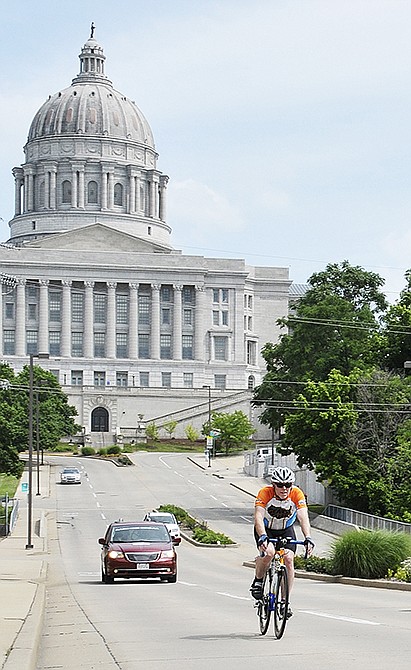The Midwest sun rained down oppressive heat on Jefferson Street as cyclist after cyclist peddled towards their goal - the East coast on Wednesday afternoon.
The breeze offered little respite from the humidity that mixed with the exhaust fumes of cars speeding down U.S. 54. The conditions are what people are enduring while riding bicycles from California to Maryland.
For 33 years, Race Across America has seen cyclists from all corners of the world come to the U.S. to compete with each other and the environments across the country. Racers of mixed genders and ages ride solo or in teams of two, four or eight. Their starting point was in Oceanside, Calif., the finish line is in Annapolis, Md. The solo racers took off on June 10, and the teams left four days later.
More than 200 cyclists will cover more than 3,000 miles before the race is over, according to the site raceacrossamerica.org. They will climb from elevations as low as 170 feet to as high as 10,000 feet above sea level. Through the race the bicyclists brave desert drought and dry heat along with mountain chains and thunderstorms all the way to the east coast.
"These people are from Korea, Denmark, England, Germany, just about everywhere. It is amazing where they come from," said Pat Struempf, manager of Time Station 33 in Jefferson City. "This is a different kind of race, it is not NASCAR. It is just not a spectator sport."
He explained the racers don't always stop at the station. Many rest less than three hours a night, especially racers who do it by themselves. By the time they reach his time station, the racers have traveled more than 1,900 miles. Struempf said would never even dream of riding in this competition.
"These people are just rugged individuals," Struempf said. "It is just for personal accomplishment. They're an odd lot because you can be a terrific bicyclist and you can train, but if you don't know how to keep going when your body says you can't go anymore than this is not the little niche for you."
At the end of Wednesday, the teams needed to be at least to the Mississippi River to make an "official finish," he said.
"I do it for the challenge - and it's a big challenge," said Keegan Greene, rider for team Gears to a Cure. "It is a personal physical challenge for me and the people that I ride with. This is something we will talk about for a long time."
Greene's eight-man team is competing for the first time and races to raise money for research to cure multiple sclerosis. But they are not alone in their fundraising attempts. In the last five years the race has helped raise more than $5 million for different charities, according to the race website.
"It is hard, it is also amazing," Greene said. "Logistically it is almost impossible and physically it is possible, but it is difficult. Yesterday we had almost 112-degree heat in Kansas. The day before we had an almost 11,000-foot mountain pass we had to get over. We have had the desert wind blowing sand in our faces and now we get the Midwest humidity."
Their team has played a game of leapfrog with a team from Britain.
The British team had passed them at time station 32. As they rode past time station 33, they waved and shouted to the American team's resting riders.
Gears to a Cure has mounted speakers on the front of their trail vehicle, or vehicle that follows the cyclist. When they pass the British team they make an effort to play "inspirational" music such as "Eye of the Tiger" by Survivor or "We are the Champions" by Queen, said Brandon Bevin, team manager.
As he finished talking about what good sports the British racers where, he started wondering where his team's rider was. A few phone calls later, he was positioning the next cyclist on the road to continue around the state capitol and on to the next time station, nearly 75 miles away in Washington.
His newly positioned cyclist started peddling long and slow movements while another was reaching the top of the hill in the distance behind him. The biker rocketed down the hill to his slowly accelerating counterpart.
"Go! Go! Go!" he screamed as he passed his teammate, then instantly began to slow down. During the day, riders have to pass wheels to switch; at night, both have to come to a complete stop before they can continue, Bevin said.
One racer rest as another rides on, and the race continues.
Bevin is live streaming and tweeting his team's journey. He is also blogging about the experience. To see his coverage, go to gears4acurems.weebly.com.

